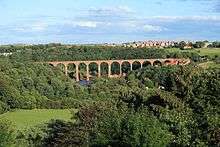Larpool Viaduct
Larpool Viaduct, also known as the Esk Valley Viaduct is a 13 arch brick viaduct built to carry the Scarborough & Whitby Railway over the River Esk, North Yorkshire, England.
Larpool Viaduct | |
|---|---|
 | |
| Coordinates | 54.474500°N 0.618450°W |
| Carries | Foot and cycle path, formerly single track railway line |
| Characteristics | |
| Total length | 305 yd (279 m) |
| Height | 120 ft (37 m) |
| No. of spans | 13 |
| History | |
| Opened | c. 1885 |

| |
History and description
The viaduct was constructed for the Scarborough and Whitby Railway to carry a single track line over the River Esk and valley near Whitby, as well as crossing the Esk Valley Railway, and Whitby, Redcar and Middlesbrough Union Railway. Due to its situation close to the sea the design avoided the use of iron, using brick and cement construction; the design was based on the Saltburn Viaduct.[1] Construction began in October 1882 and was complete by October 1884; two men fell from the piers during construction, but recovered.[2] The resident engineer was Charles Arthur Rowlandson, the contractors were John Waddell and Sons.[3]
The viaduct is a 13 arch structure, 305 yd (279 m) long, with the rail level reaching 120 ft (37 m) high. The foundations on land were excavated to the level of rock, and formed from slag based cement. The river foundations were excavated in brick lined wells. The river foundation excavations were complicated by large oak trees found embedded in the river, which required divers for manual removal.[4] Piers 5,7,8 and 9 had triple foundations, connected above the water level by two semicircular arches.[5] Three of the piers in the river are skewed so as not to deflect the tidal flow (the River Esk is tidal as far as Ruswarp upstream).[6][7]
The main arches are 55 to 65 ft (17 to 20 m) wide, and 27 ft 6 in (8.38 m) high, made of bricks seven deep, 2 ft 9 in (0.84 m). The width between the parapets is 14 ft 6 in (4.42 m) on straight sections.[8]
Services on the line ended in March 1965 as a result of the Beeching Report.[9]
The viaduct became grade II listed in 1972.[10] In 2000 much of the former line and the viaduct were opened to the public. By 2006 parts of the brickwork had become unsafe due to spalling, and the parts of the outer layer were replaced.[9] As of 2012 the viaduct is part of the 'Scarborough to Whitby Rail Trail', also promoted as the "Scarborough to Whitby Cinder Track",[11] a cycle route.[12]
The viaduct is mentioned in Bram Stoker's 1897 novel Dracula:
The little river, the Esk, runs through a deep valley, which broadens out as it comes near the harbour. A great viaduct runs across, with high piers, through which the view seems somehow further away than it really is.
The viaduct is featured in the December 2007 episode of Heartbeat entitled "Another Sleepy, Dusty, Delta Day".
References
- Fox 1886, pp. 303–4.
- Fox 1886, p. 309.
- Fox 1886, p. 311.
- Fox 1886, pp. 304–5.
- Fox 1886, pp. 306–7.
- "Larpool Viaduct". Forgotten Relics of an Enterprising Age. Retrieved 28 November 2015.
- "River Esk (Yorkshire) Tideway Byelaw Report" (PDF). North York Moors. Environment Agency. p. 7. Retrieved 28 November 2015.
- Fox 1886, pp. 307–8.
- Garrity, Stephen W. "THE REHABILITATION OF A VICTORIAN CLAY BRICK RAILWAY VIADUCT" (PDF). Proceedings of 8th International Conference on Short and Medium Span Bridges.
- Historic England. "Viaduct at Larpool (1366577)". National Heritage List for England. Retrieved 5 December 2012.
- "The Cinder Track". www.gatewaywhitby.co.uk. Retrieved 17 August 2012.
- "Scarborough to Whitby railway (the 'Cinder Track')". www.northyorkmoors.org.uk. Retrieved 25 November 2016.
- Stoker, Bram (1897). "6". Dracula. pp. 1–19. Retrieved 28 November 2015.
Sources
- Fox, F. (1886). "Viaduct over the River Esk at Whitby and Culverts in the Ravines. (Including Plate at Back of Volume)". Minutes of the Proceedings. 86 (1886): 303. doi:10.1680/imotp.1886.21174.CS1 maint: ref=harv (link)
External links
| Wikimedia Commons has media related to River Esk Railway Viaduct, Whitby. |